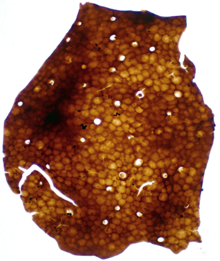Cosmochlaina
|
Cosmochlaina Temporal range: Late Silurian to Early Devonian |
|
|---|---|
 |
|
| Cuticle of Cosmochlaina, retrieved from the Burgsvik beds by acid maceration. Cells about 12 μm in diameter. | |
| Scientific classification | |
| Kingdom: | Plantae (?) |
| Phylum: | Nematophyta |
| Class: | †Nematophytina |
| Order: | †Nematophytales |
| Family: |
†Nematothalaceae Strother 1993 |
| Genus: |
Cosmochlaina Edwards 1986 |
| Species | |
|
|
Cosmochlaina (from Greek: kosmos=ornament; xlaina=wrapper/cloak) is a form genus of nematophyte – an early (Silurian – Devonian) plant known only from fossil cuticles, often found in association with tubular structures.
The form genus was put forwards by Dianne Edwards, and is diagnosed by inwards-pointing flanges and randomly oriented pseudo-cellular units. Projections on the outer surface are always present, and sometimes also appear on the inner surface; however, the surface of the cuticle itself is always smooth. The holes in the cuticle are often covered by round flaps, loosely attached along a side.
Where Nematothallus was sometimes used to relate only to tube-like structures, Cosmochlaina was used in reference to the cuticle fragments. Material discovered later revealed its internal anatomy, which comprises a lichen-like mat of 'hyphae'.
It has been suggested that the pores of Cosmochlaina represent broken-off rhizoids, on the basis that rotting and acid treatment of extant liverworts produces a similar perforated texture. However, the status of this form genus in any one kingdom is not secure; members could, for example, represent arthropod cuticle. Alternatively, different species may in fact represent different parts of the same organism. Based on the more recent material, a lichen affinity seems most plausible.
...
Wikipedia
